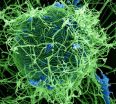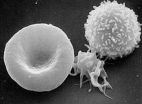(Press-News.org) An enzyme therapy may prevent skeletal abnormalities associated with the genetic disorder neurofibromatosis type-1, Vanderbilt investigators have discovered.
The researchers demonstrated in a mouse model of the disorder that the enzyme asfotase-alpha improves bone growth, mineralization and strength. The findings, reported in the August issue of Nature Medicine, "suggest that we can make bone stronger and better by injecting this drug, and possibly prevent fractures in patients with neurofibromatosis," said Florent Elefteriou, Ph.D., director of the Vanderbilt Center for Bone Biology.
While he is excited about the results, Elefteriou emphasized the challenge of moving from mouse to human studies. "It's very difficult to set up a clinical trial in patients with a rare disease; it will have to be an international effort to pool these patients," he said.
Neurofibromatosis type-1 (NF1) is caused by mutations in the gene for neurofibromin, a protein that regulates cellular signaling pathways. The disorder causes nervous system tumors and skeletal pathologies including scoliosis, bone fragility, fracture and pseudoarthrosis (non-union of the bone following fracture).
Fractures are treated surgically to stabilize the bone and promote healing. Some families opt for amputation, to spare their children the pain of repeated surgeries, Elefteriou said.
"We wondered if there might be a way to prevent the fractures from happening in the first place," he said.
It was difficult to even propose non-surgical preventive treatments, however, because it was unclear how mutations in neurofibromin cause skeletal pathologies.
To investigate the molecular pathology of NF1, Elefteriou and his colleagues, including first author Jean de la Croix Ndong, Ph.D., have studied a mouse model of the disorder. They noticed in histological stains of bone tissue that the mice had an accumulation of non-mineralized matrix, a condition called hyperosteoidosis.
They have now discovered that hyperosteoidosis in the mice is caused by accumulation of the molecule pyrophosphate, a strong inhibitor of bone mineralization. They found that in the absence of neurofibromin, the expression of certain genes is upregulated. These include genes that enable increased production and transport of pyrophosphate and a gene that prevents calcium and phosphate from depositing on collagen fibers.
In addition, the bone-forming cells fail to differentiate (mature) into "proper tenure-track osteoblasts," Elefteriou said, which means the cells don't produce alkaline phosphatase, the enzyme that normally breaks down pyrophosphate.
"That's a fourth factor preventing mineralization and the formation of new good bone," he said.
The investigators decided to try clearing the accumulated pyrophosphate by treating the mice with asfotase-alpha, an engineered form of alkaline phosphatase.
Asfotase-alpha is currently in clinical trials for hypophosphatasia, another rare genetic disease affecting bone formation.
They found that asfotase-alpha treatment improved bone mass, mineralization and bone mechanical properties in the mouse model of NF1.
"This could be a drug that would prevent fractures and help these kids pass through the early rapid growth period and reach the point where they aren't as likely to fracture the bone," Elefteriou said.
To explore whether the molecular pathology of the disease is the same in humans as in the mouse model, the researchers studied pseudoarthrosis tissue biopsies from patients with NF1. They found that the gene that promotes pyrophosphate synthesis is upregulated, suggesting a similar molecular pathology and supporting the notion that asfotase-alpha may be a successful treatment in patients.
There's much work to be done first, Elefteriou cautions. He notes that although the enzyme therapy corrects the functional defect of pyrophosphate accumulation, it does not correct the failure of osteoblasts to differentiate. This may indicate a need for long-term and combination drug therapy, which the researchers will examine in the mouse model.
They will also continue to collaborate with members of the Children's Tumor Foundation Bone Consortium to develop clinical trials.
"I think we've made great progress in this area," Elefteriou said. "It's exciting that instead of fixing the bones after they break, we might have a drug now to prevent the fractures."
INFORMATION:
Other Vanderbilt Center for Bone Biology contributors to the studies included Alexander Makowski, Sasidhar Uppuganti, Guillaume Vignaux, Ph.D., Koichiro Ono, Ph.D., Daniel Perrien, Ph.D., and Jeffry Nyman, Ph.D. Additional contributors included Simon Joubert, Ph.D., at Alexion Pharmaceuticals, Serena Baglio, Ph.D., and Donatella Granchi, Ph.D., at Istituto Ortopedico Rizzoli in Bologna, Italy, David Stevenson, M.D., at the University of Utah and Jonathan Rios, Ph.D., at University of Texas Southwestern Medical Center.
This research was supported by a Young Investigator Award from the Children's Tumor Foundation and by grants from the National Institutes of Health (AR055966, RR027631, TR001105).
Novel treatment strengthens bones in genetic disease neurofibromatosis type-1
2014-08-14
ELSE PRESS RELEASES FROM THIS DATE:
NTU gene research promises better treatment procedures for children with leukemia
2014-08-14
A research team led by Nanyang Technological University (NTU) scientists have made a key finding which is expected to open up improved treatment possibilities for children suffering from leukaemia.
They found that two in three cases of acute lymphoblastic leukaemia, a type of cancer of the white blood cells, may be caused by mutations in one of the two key genes found in children. These genes are however more prevalent in those with Down syndrome.
This means that scientists can design better tailored treatment protocols, depending on which mutating gene is carried ...
New technology offers insight into cholesterol
2014-08-14
Researchers from the Copenhagen Center for Glycomics at the University of Copenhagen have studied an important receptor protein called LDLR using new, groundbreaking techniques. The protein plays an important role in the absorption of the bad cholesterol, LDL.
The findings have just been published in the Journal of Biological Chemistry.
The key to major discoveries within the fields of health and diseases is not just hidden in the human DNA code. The proteins encoded by the genes also play an important role, not least the attached sugar chains which give the proteins ...
Study details shortage of replication in education research
2014-08-14
WASHINGTON, D.C., August 14, 2014 – Although replicating important findings is essential for helping education research improve its usefulness to policymakers and practitioners, less than one percent of the articles published in the top education research journals are replication studies, according to new research published today in Educational Researcher (ER), a peer-reviewed journal of the American Educational Research Association.
"Facts Are More Important Than Novelty: Replication in the Education Sciences," by Matthew C. Makel of Duke University and Jonathan A. ...
PTSD can develop even without memory of the trauma
2014-08-14
Philadelphia, PA, August 14, 2014 – There are many forms of memory and only some of these may be critical for the development of posttraumatic stress disorder (PTSD), reports a new study by researchers at the University at Albany and the University of California Los Angeles. Their findings, published in the current issue of Biological Psychiatry, suggest that even with no explicit memory of an early childhood trauma, symptoms of PTSD can still develop in adulthood.
There are case reports of people who have experienced terrible life events that resulted in brain damage, ...
New Irish research sheds light on how aspirin works to reduce cancer deaths
2014-08-14
Researchers have discovered that women who had been prescribed aspirin regularly before being diagnosed with breast cancer are less likely to have cancer that spread to the lymph-nodes than women who were not on prescription aspirin. These women are also less likely to die from their breast cancer.
The study of Irish patients funded by the Irish Health Research Board and Irish Cancer Society and published by the American Association for Cancer Research in the Journal, Cancer Research, analyses records from the National Cancer Registry Ireland (NCRI), and prescription ...
New non-invasive technique controls size of molecules penetrating the blood-brain barrier
2014-08-14
New York, NY—August 14, 2014—A new technique developed by Elisa Konofagou, associate professor of biomedical engineering and radiology at Columbia Engineering, has demonstrated for the first time that the size of molecules penetrating the blood-brain barrier (BBB) can be controlled using acoustic pressure—the pressure of an ultrasound beam—to let specific molecules through. The study was published in the July issue of the Journal of Cerebral Blood Flow & Metabolism.
"This is an important breakthrough in getting drugs delivered to specific parts of the brain precisely, ...
Workaholism: The addiction of this century
2014-08-14
In spite of the many positive aspects of work, some people are unable to detach from it – working excessively and compulsively. These are called workaholics.
Postdoctoral Fellow Cecilie Schou Andreassen and colleagues from the Department of Psychosocial Science at the University of Bergen (UiB) in Norway has been the first to assess workaholism in a nationally representative sample.
According to Schou Andreassen, the "workaholism" concept has been studied by scholars for nearly 45 years. Still, reliable statistics on the prevalence of workaholism is hard to find. The ...
EARTH Magazine: La Brea climate adaptation as different as cats and dogs
2014-08-14
Alexandria, Va. — The La Brea tar pits in downtown Los Angeles are a famous predator trap. For every herbivore, a dozen or more carnivores — saber-toothed cats and dire wolves chief among them — are pulled from the prolific Pleistocene fossil site. In fact, the remains of more than 4,000 dire wolves have been excavated, along with more than 2,000 saber-toothed cats. The sheer number of fossils allows researchers to ask population-level questions about the climate and environment as well as how these animals evolved.
Now, two new studies focusing dire wolves and saber-toothed ...
Ebola outbreak highlights global disparities in health-care resources
2014-08-14
The outbreak of Ebola virus disease that has claimed more than 1,000 lives in West Africa this year poses a serious, ongoing threat to that region: the spread to capital cities and Nigeria—Africa's most populous nation—presents new challenges for healthcare professionals. The situation has garnered significant attention and fear around the world, but proven public health measures and sharpened clinical vigilance will contain the epidemic and thwart a global spread, according to a new commentary by Anthony S. Fauci, M.D., director of the National Institute of Allergy and ...
New blood: Tracing the beginnings of hematopoietic stem cells
2014-08-14
Hematopoietic stem cells (HSCs) give rise to all other blood cell types, but their development and how their fate is determined has long remained a mystery. In a paper published online this week in Nature, researchers at the University of California, San Diego School of Medicine elaborate upon a crucial signaling pathway and the role of key proteins, which may help clear the way to generate HSCs from human pluripotent precursors, similar to advances with other kinds of tissue stem cells.
Principal investigator David Traver, PhD, professor in the Department of Cellular ...



